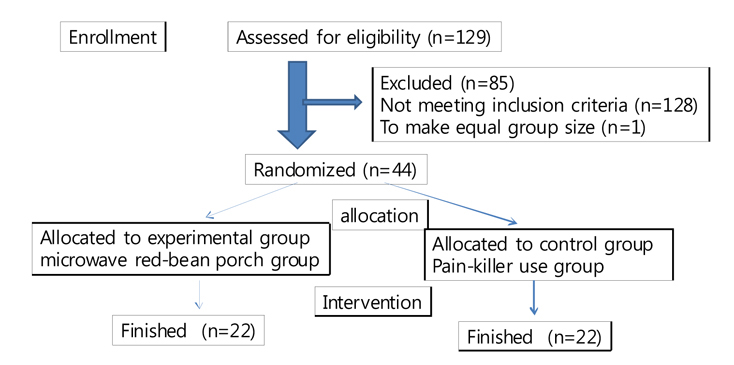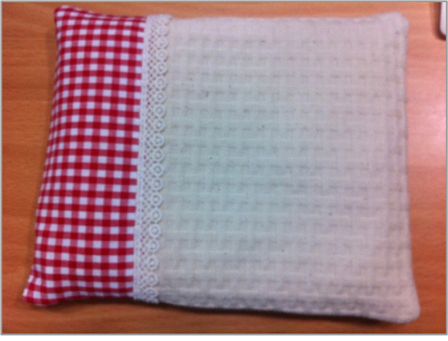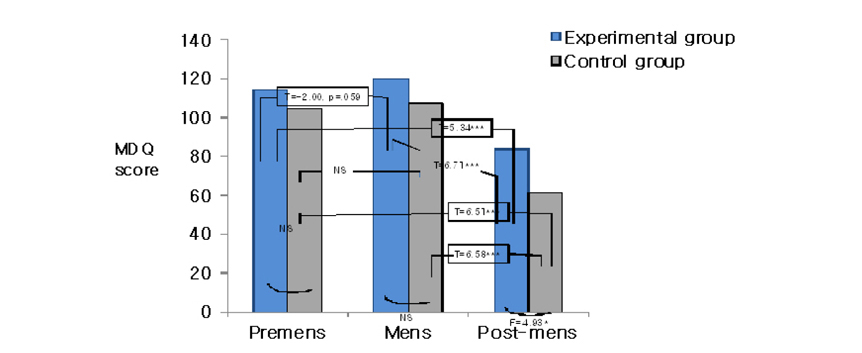Korean J Women Health Nurs.
2013 Jun;19(2):67-74. 10.4069/kjwhn.2013.19.2.67.
Effect of Heated Red Bean Pillow Application for College Women with Dysmenorrhea
- Affiliations
-
- 1School of Nursing, SoonChunHyang University, Chonan, Korea. jeungim@sch.ac.kr
- KMID: 2308271
- DOI: http://doi.org/10.4069/kjwhn.2013.19.2.67
Abstract
- PURPOSE
Dysmenorrhea is a menstrual condition characterized by severe and frequent cramps and pain. Effective treatment methods for dysmenorrhea are not yet fully understood. This research compares the effects of pain killers and heated red bean pillows.
METHODS
Data were got on demographic data, menstrual cycle status, and activities of daily living (ADLs) limitations, dysmenorrhea severity and menstrual pain scores. Following a 10% drop-out rate, 44 young women satisfied the inclusion criteria. To prevent any bias, the experimental and control groups were selected from different campuses. We used two sizes of red bean pillows: 15x18 cm, weighing 400g; and 13x11.5 cm, weighing 220g. For analysis, we used IBM SPSS statistics 19.0.
RESULTS
Ninety-nine point seven percentage of total subjects reported moderate to severe dysmenorrhea and 63.6% reported as moderate to severe daily activities limitations. The mean pain score with visual analogue scale was 80.2+/-9.42 of 100 and 86.4% used pain killers to alleviate menstrual discomfort in all the subjects. In both groups, all three variables showed significant improvement and the Moos's Menstrual Distress Questionnaire (MDQ) scores changed significantly between menstrual and post-menstrual time point at within groups and not significantly different at premenstrual and menstrual time point at between groups. However, the MDQ score was significantly higher in experimental group than control group at post-menstruation time point and the degree of satisfaction was higher in the control group.
CONCLUSION
This research shows that red-bean pillows on the abdomen are effective in assisting the ADL and diminishing pain severity. With regard to its safety the study indicates it can be a convenient and safe option for female students with menstrual discomfort in schoolas a non-pharmacological self-help.
Keyword
MeSH Terms
Figure
Cited by 1 articles
-
Effects of Menstrual Self-management Education Program on Knowledge and Behavior of Menstrual Self-management in High School Girls
Jeonghye Min, Sukhee Ahn
Korean J Women Health Nurs. 2018;24(3):310-321. doi: 10.4069/kjwhn.2018.24.3.310.
Reference
-
1. Akin M, Price W, Rodriguez G Jr, Erasala G, Hurley G, Smith RP. Continuous, low-level, topical heat wrap therapy as compared to acetaminophen for primary dysmenorrhea. J Reprod Med. 2004; 49:739–745.2. Anandha Lakshmi S, Priy M, Saraswathi I, Saravanan A, Ramamchandran C. Prevalence of premenstrual syndrome and dysmenorrhea among medical students and its association with college absenteeism. Int J Biol Med Res. 2011; 2:1011–1016.3. Banikarim C, Middleman AB, GeVner M, Hoppin AG. Primary dysmenorrhea in adolescents. 2011. Retrieved December 1. from http://www.uptodate.com.4. Burnett MA, Antao V, Black A, Feldman K, Grenville A, Lea R, et al. Prevalence of primary dysmenorrhea in Canada. J Obstet Gynaecol Can. 2005; 27:765–770.
Article5. Burton WN, Morrison A, Wertheimer AI. Pharmaceuticals and worker productivity loss: A critical review of the literature. J Occup Environ Med. 2003; 45:610–621.
Article6. Cakir M, Mungan I, Karakas T, Girisken I, Okten A. Menstrual pattern and common menstrual disorders among university students in Turkey. Pediatr Int. 2007; 49:938–942.
Article7. Chang SB, Jun EM. Effects of SP-6 acupressure on dysmenorrhea, cortisol, epinephrine and norepinephrine in the college students. J Korean Acad Nurs. 2003; 33:1038–1046.
Article8. Dawood MY. Primary dysmenorrhea: Advances in pathogenesis and management. Obstet Gynecol. 2006; 108:428–441.9. Gharloghi S, Torkzahrani S, Akbarzadeh AR, Heshmat R. The effects of acupressure on severity of primarydysmenorrhea. Patient Prefer Adherence. 2012; 6:137–142. http://dx.doi.org/10.2147/PPA.S27127.10. French L. Dysmenorrhea. Am Fam Physician. 2005; 71:285–291.11. Han SH, Hur MH, Buckle J, Choi J, Lee MS. Effect of aromatherapy on symptoms of dysmenorrhea in college students: A randomized placebo-controlled clinical trial. J Altern Complement Med. 2006; 12:535–541.
Article12. Harlow SD, Park M. A longitudinal study of risk factors for the occurrence, duration and severity of menstrual cramps in a cohort of college women. Br J Obstet Gynaecol. 1996; 103:1134–1142.
Article13. Hosono T, Takashima Y, Morita Y, Nishimura Y, Sugita Y, Isami C, et al. Effects of a heat- and steam-generating sheet on relieving symptoms of primary dysmenorrhea in young women. J Obstet Gynaecol Res. 2010; 36:818–824. http://dx.doi.org/10.1111/j.1447-0756.2010.01237.x.
Article14. Jun EM, Chang S, Kang DH, Kim S. Effects of acupressure on dysmenorrhea and skin temperature changes in college students: A non-randomized controlled trial. Int J Nurs Stud. 2007; 44:973–981.
Article15. Kim HO, Lim SW, Woo HY, Kim KH. Premenstrual syndrome and dysmenorrhea in Korean adolescent girls. Korean J Obstet Gynecol. 2008; 51:1322–1329.16. Kim JH, Park MK, Oh MR. Meta-analysis of complementary and alternative intervention on menstrual distress. Korean J Women Health Nurs. 2013; 19:23–35. http://dx.doi.org/10.4069/kjwhn.2013.19.1.23.
Article17. Mahvash N, Eidy A, Mehdi K, Zahra MT, Mani M, Shahla H. The effect of physical activity on primary dysmenorrhea of female university students. World Appl Sci J. 2012; 17:1246–1252.18. Marjoribanks J, Proctor M, Farquhar C, Derks RS. Nonsteroidal anti-inflammatory drugs for dysmenorrhea. Cochrane Database Syst Rev. 2010; (1):CD001751. http://dx.doi.org/10.1002/14651858.CD001751.pub2.19. Mishra SK, Mukhopadhyay S. Socioeconomic correlates of reproductive morbidity among adolescent girls in Sikkim India. Asia Pac J Public Health. 2012; 24:136–150. http://dx.doi.org/10.1177/1010539510375842.
Article20. Moos RH. The development of a menstrual questionnaire. Psychosom Med. 1968; 30:853–867. Retrieved January 10, 2012, from http://www.psychosomaticmedicine.org/content/30/6/853.full.pdf.21. Navvabi Rigi S, Kerman-Saravi F, Navidian A, Safabakhsh L, Safarzadeh A, Khazaian S, et al. Comparing the analgesic effect of heat patch containing iron chip and ibuprofen for primary dysmenorrhea: A randomized controlled trial. BMC Womens Health. 2012; 12:25. Retrieved November 28, 2012, from http://www.biomedcentral.com/1472-6874/12/25. http://dx.doi.org/10.1186/1472-6874-12-25.
Article22. Nohara M, Momoeda M, Kubota T, Nakabayashi M. Menstrual cycle and menstrual pain problems and related risk factors among Japanese female workers. Ind Health. 2011; 49:228–234.
Article23. Patel V, Tanksale V, Sahasrabhojanee M, Gupte S, Nevrekar P. The burden and determinants of dysmenorrhea: A population-based survey of 2262 women in Goa, India. BJOG. 2006; 113:453–463.24. Pinar G, Colak M, Oksuz E. Premenstrual syndrome in Turkish college students and its effects on life quality. Sex Reprod Healthc. 2011; 2:21–27. http://dx.doi.org/10.1016/j.srhc.2010.10.001.
Article25. Rakhshaee Z. Effect of three yoga poses (cobra, cat and fish poses) in women with primary dysmenorrhea: A randomized clinical trial. J Pediatr Adolesc Gynecol. 2011; 24:192–196. http://dx.doi.org/10.1016/j.jpag.2011.01.059.
Article26. Shin YI, Kim NG, Park KJ, Kim DW, Hong GY, Shin BC. Skin adhesive low-level light therapy for dysmenorrhoea: A randomized, double-blind, placebocontrolled, pilot trial. Arch Gynecol Obstet. 2012; 286:947–952. http://dx.doi.org/10.1007/s00404-012-2380-9.
Article27. Smith RP, Kaunitz AM, Barbieri RL, Barss VA. Pathogenesis, clinical manifestations, and diagnosis of primary dysmenorrhea in adult women. Retrieved December 1, 2012. from http://www.uptodate.com.28. Tramer MR, Moore RA, Reynolds DJ, McQuay HJ. Quantitative estimation of rare adverse events which follow a biological progression: A new model applied to chronic NSAID use. Pain. 2000; 85:169–182.29. Yamamoto K, Okazaki A, Sakamoto Y, Funatsu M. The relationship between premenstrual symptoms, menstrual Pain, irregular menstrual cycles, and psychosocial stress among Japanese college students. J Physiol Anthropol. 2009; 28:129–136.
Article
- Full Text Links
- Actions
-
Cited
- CITED
-
- Close
- Share
- Similar articles
-
- A Study on the Dysmenorrhea in College Female Students
- Effect of Self Moxibustion on Dysmenorrhea and Activities of Daily Living in Female College Students
- A Phenomenological Study on Dysmenorrhea Experience of Women
- Stellate Ganglion Block for the Treatment of Primary Dysmenorrhea
- Lived Experience of Women with Severe Dysmenorrhea




